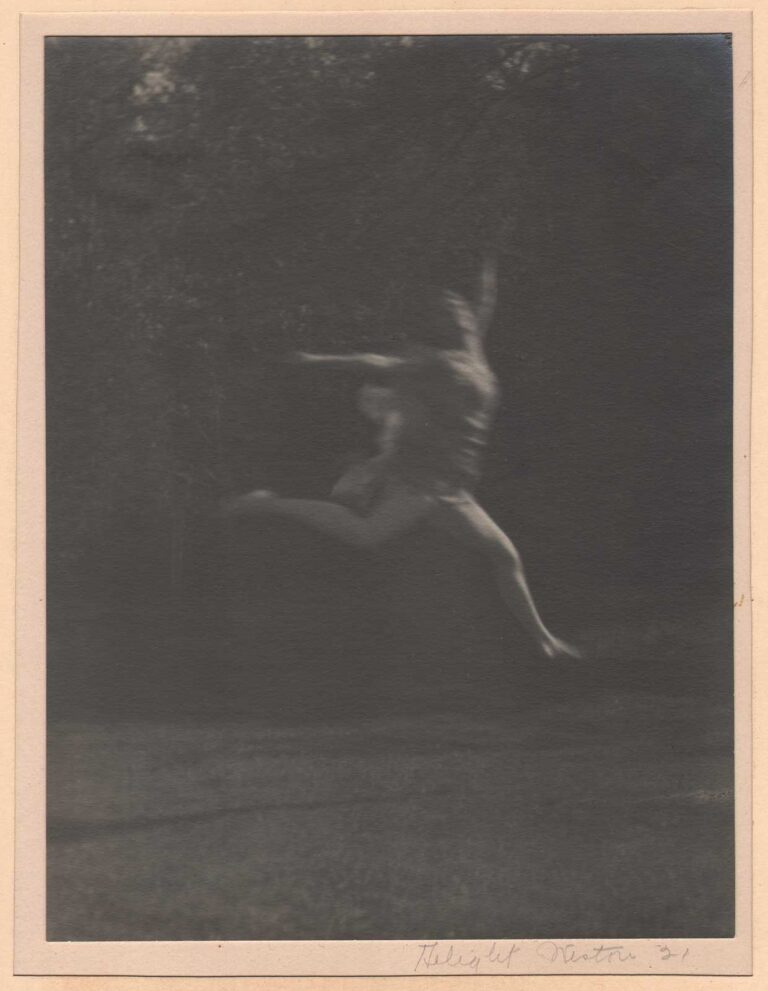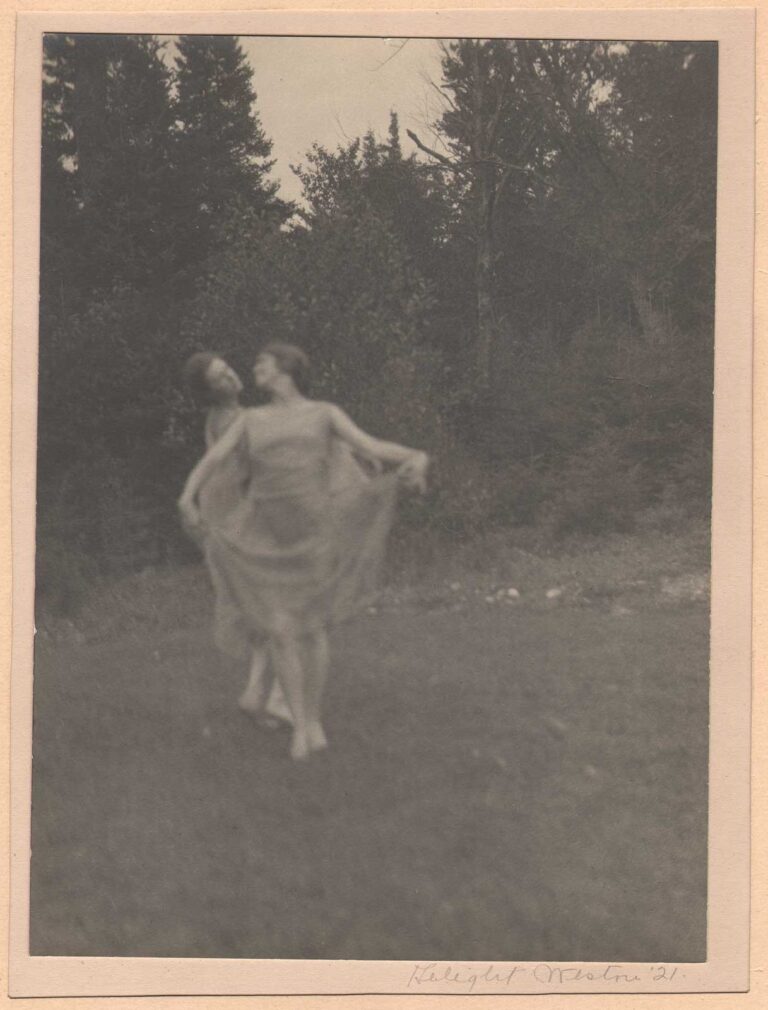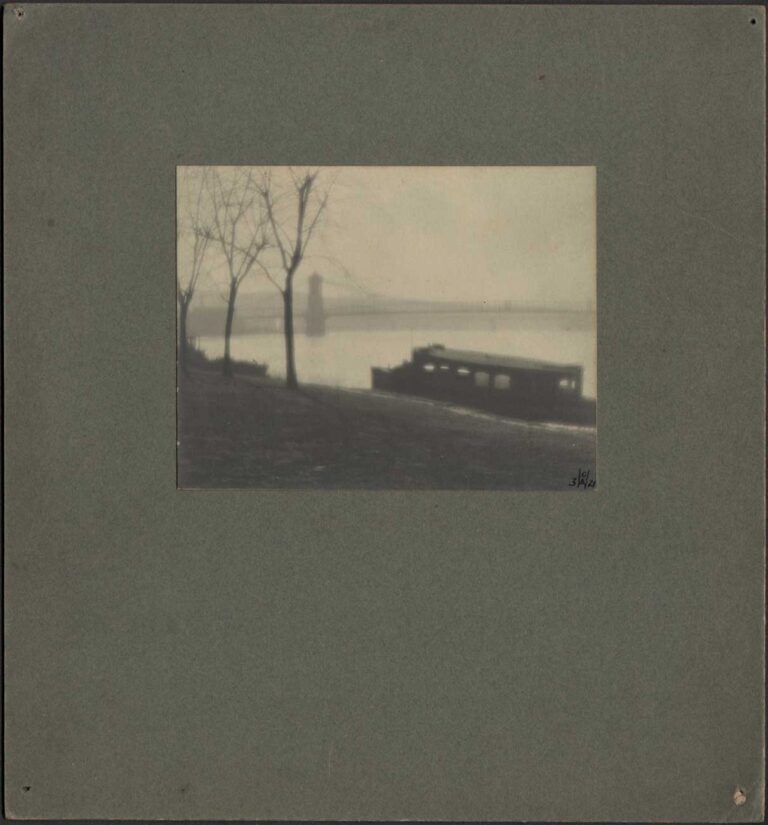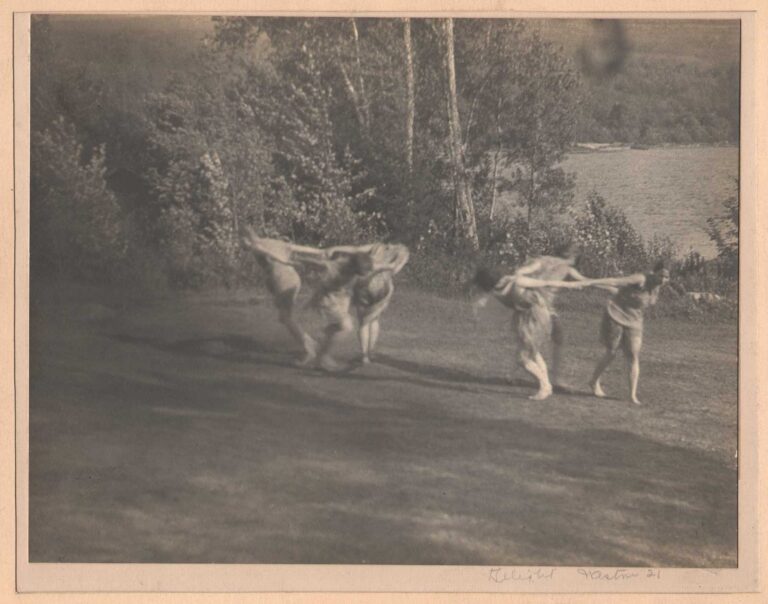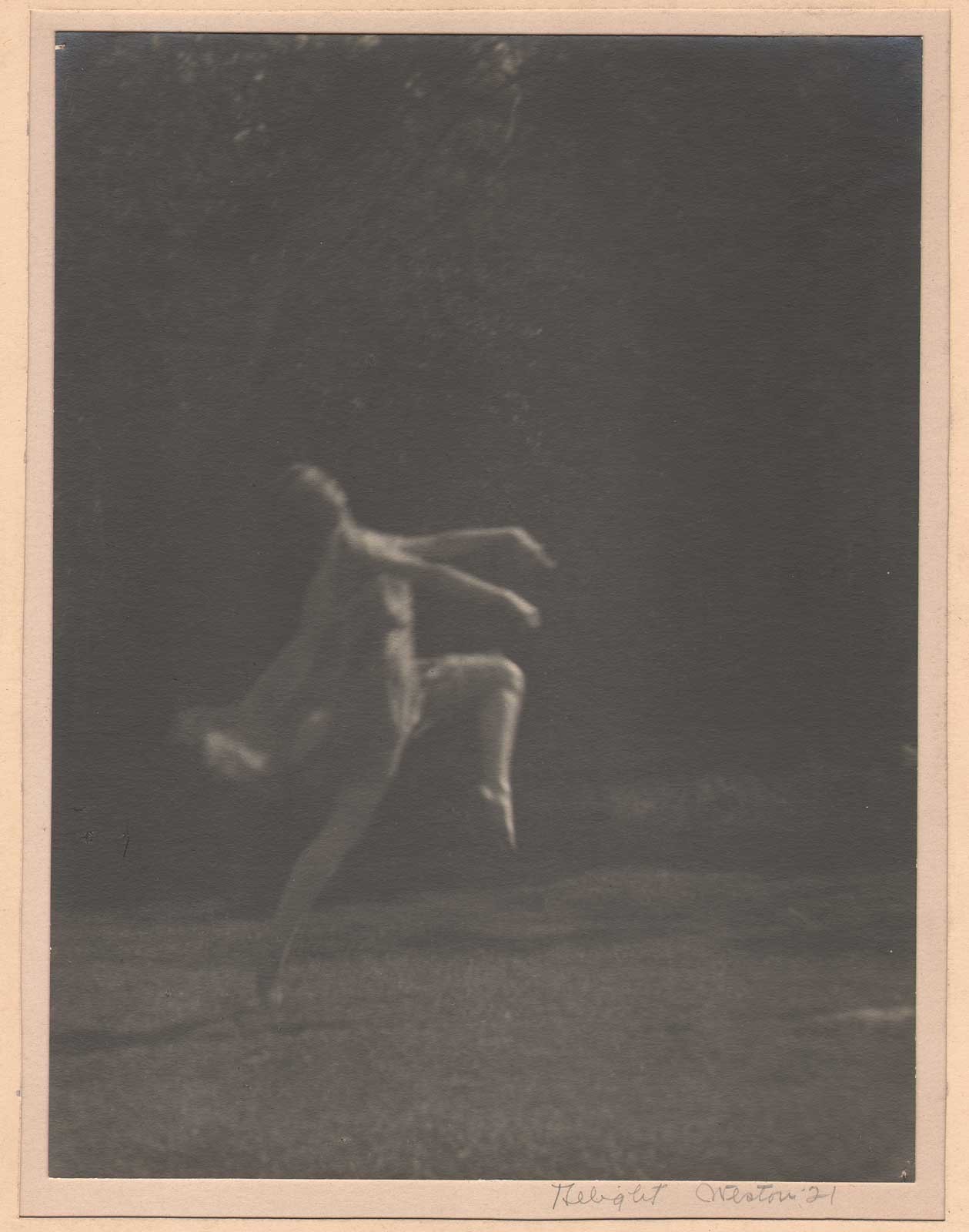
Dance Liftoff
This pictorial study of a female dancer in the act of leaping airborne is believed to have been taken at the former Ruth Doing Camp for Rhythmics in New York state’s Adirondack mountains. In the 1920’s and 30’s, photographer Delight Weston lived with camp founders Ruth Doing (1881-1966) and Gail Gardner (1878-1949) in New York City, along with other women artists, in a building at 139 W. 56th St. near Carnegie Hall.
Established in 1916, the summer camp was first located on the shores of Upper Chateaugay lake near Lyon Mountain until 1925, (1.) when it moved to Upper St. Regis Lake in Paul Smiths, New York. (2.) Renamed the Gardner-Doing Camp after this time, it was coeducational: besides regular summer camp activities, it specialized in the “rhythmic” style of dancing popularized by famed dancer Isadora Duncan, whom Ruth Doing was a former student of. Doing’s life partner, Michigan native Gail Gardner, had earlier made a name for herself as an accomplished and world-traveling opera singer.
Another important artistic connection with this photograph is to notable American wood sculptor Wharton Esherick. (1887-1970) Beginning in 1920, he and his family spent their summers at this camp, with dance studies similar to this example- possibly by Delight Weston- contained in a family album along with Esherick’s many quick-sketch drawings: evidence that are known to have aided, complemented and influenced his emerging artistic style:
The Ruth Doing School of Rhythmics was a dance camp run by Ruth Doing, a former dancer and student of Isadora Duncan, with her business and life partner Gail Gardner in the Adirondack Mountains of New York. The Esherick family spent their summers there starting in 1920. In the fall of 1923 Ruth Doing taught dance classes in Philadelphia, assisted by Letty Esherick, Wharton’s wife. Watching and drawing the dancers and their movements heavily influenced Wharton Esherick’s artistic style; his drawings and designs became more free and flowing. At the camp Wharton also was introduced to Austrian philosopher Rudolph Steiner’s “organic functionalist” design theory, which impacted his style. (3.)
Although unidentified and dated one year later, the intriguing possibility exists the dancer in this photograph may be of camp co-founder Ruth Doing or Doris Canfield (1895-1993) in motion, with surviving plaster sculptures by Wharton Esherick done in 1920 on display in his namesake museum:
Two early plaster sculptures, which now sit in Esherick’s bedroom, depict dancers from the camp, one of Ruth Doing, the other of dancer and actress Doris Canfield. Both done in 1920, these are very academic for Esherick, though the essential design elements (like the spiral) would show up again and again in Esherick’s work in progressively bolder and more modern designs. (4.)
In addition to these sculptures, sketches of dancing figures done as quick studies on paper by Esherick are in the museum’s collection:
As a regular visitor to the Gardner Doing Dance Camp, Esherick observed dancers like Canfield exploring eurythmy, Rhythmic dance, and other modern dance forms. His wife Letty also danced, sometimes holding classes at their home in Paoli. At times, Esherick joined in with the dance. Otherwise, he was sketching away, attempting to capture bodies in motion. (5.)
Short Biography: Irma Delight Weston: 1887-1968
1887: Born Irma Delight Weston on April 29 in Dayton, OH to Edward Banning Weston (1864-1932) and Blanche Phillips Weston. (1867-1929) Her father was president of the Weston Paper & Manufacturing Company, the Rockford Paper Mill Company, and the Auglaize Box Board Company, all of Dayton. Irma’s middle name- Delight- is named for her maternal grandmother Delight Sylvina Allen Phillips. (1838-1909)
1909: Irma Delight Weston graduates from Smith College, Northampton, MA. Her home address listed in the Smith College class book is 102 Sunset Ave., Dayton, OH.
– A newspaper article in The Daily Enquirer of Carlinville, Ill published on August 14 states Delight Weston was the first American woman to own a balloon, although this may be false. (see footnote #6) Article: GETS BALLOON AS A GIFT | Novel Graduation Present Given Young Lady by Her Father. “Delight Weston, eighteen (sic-22) and pretty, of Indiana, (sic-Ohio) is the first American woman to own a balloon. It is just as much hers as her pet poodle or her racing automobile, and she will make her first ascension in it Friday from Dayton, Ohio. Miss Weston is the daughter of E. B. Weston, millionaire president of the Terre Haute Paper company, and the balloon, which is of standard size, was her father’s present to her at graduation from Smith college.” (this wire service article continues, and published around this time in multiple American newspapers including the Chicago Inter Ocean and Indiana’s Evansville Press)
1917: Completed a course of instruction at the Clarence H. White School of Photography in New York City.
– Photographs the important Polish-American suffragist Ruza Wenclawska. (1889-1977) Her portrait appears in the 1917 White School class album dedicated to Clarence White now held by Princeton University.
– Her father E.B. Weston has a balloon constructed around this time which he names “The Delight” after his daughter. It is not known if she was an aeronaut like her father, with online references erroneously stating she was the first American woman to own a hot-air balloon. (6.)
– Her photographs were included in the traveling Pictorial Photographers of America shows that traveled from 1917-18 in New England and the Midwest. (source: biography: “Creative Continuum: The Pictorial Photographers of America 1916-1950 by Christian A. Peterson, 2019. p. 141.
1918: At this time or earlier, she was spending summers in Blue Hill, Maine, with this address included in the catalogue “Pictorial Photographs By American Artists. Under the Joint Auspices of the Camera Club of Detroit and the Detroit Museum of Art” held January 4-28 at the museum.
1920: Annual Register of the Alumnae Association of Smith College lists Weston’s address in New York City as 139 West 56th Street. (7.)
– Joins the Pictorial Photographers of America. (PPA)
– A single photograph by the photographer: “Eleanor”, showing a little girl standing with a large hoop, is published in the Pictorial Photography of America annual this year. Other photographs by Weston appear in subsequent editions. For 1921: “The Dance”, showing two female dancers intertwined before a curtain backdrop; For 1926: “Stairway, Chartres”, taken in Chartres, Centre-Val de Loire, France- an overhead cityscape study with figure was published in collotype; For 1929: “Sails” (plate 3 in pagination).
1922: Her PPA work was accepted in the Buffalo Photographic Salon and also in the Pittsburgh Salon: with the former also accepting it for their 1923 and 1925 salons. (source: biography reference above for 1917)
1923: Her PPA work included in the groups New York international salon.
1924: The Smith Alumnae Quarterly states:
“Delight Weston has returned from a trip to Bermuda and has opened her studio at 446 W. 24 St., New York, where she makes charming photographs. This year she has an assistant.”
– The same year, as early as April, she takes out successive monthly advertisements in the pages of the International Studio on a page dedicated to “Photography As An Art” for her commercial portrait business, with the address she had apparently been living at since at least 1920:
DELIGHT WESTON
139 West 56th Street
New York City
Experienced in the Psychology and Art of
PORTRAITURE
She maintained her studio at this NYC address as late as 1930, as listed in The American Annual of Photography for 1930.
1926: In January, a solo show of her work appeared at The Art Center in New York City. (source: biography reference above for 1917)
1927: Executes a series of dance performance studies done on stage, perhaps in New York City.
1929: Her PPA work included in the groups New York international salon.
1968: Died on June 17 in Stamford, CT. Buried at Seaside Cemetery in Blue Hill, Hancock county Maine.
Print notes Recto: Signed in graphite by the artist in lower right corner below print on primary mount: Delight Weston ’21
Provenance: Acquired by this archive in December, 2020 from a New York City collector who purchased it at auction within the last 20 years.
Notes
1. Source: blog post: Early Rhythms: Wharton Esherick and the Gardner Doing Dance Camp (JUNE 26, 2017). At the Wharton Esherick Museum online resource. A surviving brochure held by the museum printed in 1923 puts an emphasis on the dancing curriculum and is titled “The Ruth Doing Camp for Rhythmics”. This is believed to be the first name for the camp until 1925 when it moved to Lake Regis and was renamed the Gardner-Doing Camp.
2. The Gardner-Doing camp operated in the summer months until 1946, when it was sold and renamed Camp Regis. Today it is known as Camp Regis-Applejack.
3. Source: Finding Aid: NOTABLE FRIENDS AND ASSOCIATIONS: “Wharton had close relationships with several well known people, including actresses, authors, photographers, and others. Many commissioned works from him.” : Wharton Esherick family papers 1895-1996 [bulk 1920-1970] (Philadelphia Area Archives Research Portal (PAARP) Several similar dance photographs by an unknown artist in the Esherick Family Collection were published in the volume: Wharton Esherick and the Birth of the American Modern. (2010) see “Dance Sketches”, p. 96.
4. Source: ibid: see note #1. Another interesting fact is that the summer camps co-founder, Gail Gardner, was Doris Canfield’s aunt. Doris Canfield’s mother Belle Nye had inherited a fortune after gaining a divorce when her first husband Charles Canfield, a western Michigan lumber baron, deserted her in 1905. See: “Belle Nye, the former Mrs. Canfield” February 11, 2016 in the Manistee News Advocate. Doris Canfield, (1895-1993) was employed as a teacher in the Bronxville, N.Y. school system from 1935-1970 where she taught physical eduction with an emphasis on Rhythmics.
5. Source: blog post: “Figure Drawing Meets Furniture” by Katie Wynne: August, 2020.
6. Source: article in PAPER: organ of the Technical Association of the Pulp and Paper Industry: August 20, 1919: Prominent Paper Man Enters Balloon Race | DAYTON, O., Aug. 18- E. B. Weston, president of the Weston Paper and Manufacturing Company, of this city, will enter the international balloon race to be started from St. Louis next October. This statement was given out by Mr. Weston this week. Mr. Weston has long been an enthusiastic aeronaut. Several years ago, when the balloon spirit was prevalent throughout the country, he contracted with Leo Stevens, of Indianapolis, formerly a resident of this city, to construct one for him. In recognition of the affection he sustains for his daughter, Miss Delight Weston, the big gas bag was named “The Delight.” This balloon has now been taken out and an inspection is being made of it. If it meets all requirements, it will be entered in the contest next October. Mr. Stevens is now the chief instructor for the balloon section of the United States Air Service. In the event “The Delight” proves unsatisfactory, Mr. Weston will have Mr. Stevens build him another with a capacity of 100,000 pounds. In the construction of this balloon provision will be made for the use of helium gas instead of hydrogen. (p. 39) It is believed that American Mary Myers, (1849-1932) otherwise known as “Carlotta, the Lady Aeronaut”, was the true first woman to fly and own many hot air balloons”: from Wikipedia: “Myers ran a business of manufacturing and selling passenger airship balloons and high altitude weather balloons with her husband, Carl Myers.”
7. Some interesting background on 139 West 56th Street appears as part of a two-part article on the death of famed 1920’s flapper Dorothy King, the so-called “Broadway Butterfly” found murdered in her apartment in this neighborhood in 1923: “The building at 139, refitted with “housekeeping studios,” became the hub of what appears to have been a madcap, bohemian artist community, including the well-known rhythm-dance instructor Ruth Doing, dancer Doris Canfield, opera singer Gail Gardner, photographer Delight Weston, as well as arts enthusiast Louise Bybee, all of whom lived there together and never married.” Source: Blogger site “An Open Book” from entry “Death of a Flapper: Part Two” (July 25, 2012). Ruth Doing’s studio was located on the second floor of this four story building shown in a photograph with the post from the New York Public Library archives. An incomplete web survey of primary sources lists The Ruth Doing School of Rhythm located at this address from at least 1933-1940.
